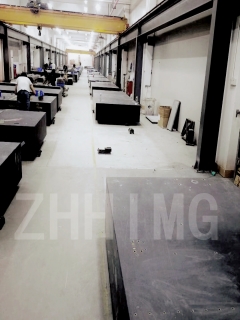Comparison of machining difficulty and cost between precision granite component and precision ceramic component
In the field of precision manufacturing, precision granite components and precision ceramic components, as two important materials, show different characteristics in terms of processing difficulty and cost. This article will compare the processing difficulty of the two and analyze how these differences affect costs.
Comparison of processing difficulty
Precision granite components:
The processing difficulty of precision granite components is relatively low, which is mainly due to its more uniform texture and high hardness. Granite as a natural stone, its internal structure is relatively stable, and has a certain toughness, so that it is not easy to collapse or fracture in the process of processing. In addition, with the advancement of machining technology, modern CNC machine tools and precision grinding technology have been able to achieve high-precision machining of granite components, such as milling, grinding, polishing, etc., so as to meet the needs of various precision measurement and mechanical manufacturing.
Precision ceramic components:
In contrast, the processing of precision ceramic components is much more difficult. Ceramic materials have high hardness, brittleness and low fracture toughness, which makes the tool wear seriously in the process of machining, cutting force is large, and it is easy to produce edge collapse and cracks. In addition, the thermal conductivity of ceramic materials is poor, and the heat generated during the cutting process is difficult to transfer quickly, which easily leads to local overheating of the workpiece and deformation or cracking. Therefore, the requirements for processing equipment, tools and process parameters are extremely high, and it is necessary to use special ceramic processing machine tools and specially designed tools, as well as precise control of the parameters in the processing process to ensure processing accuracy and surface quality.
Cost impact
Processing cost:
Because the processing difficulty of precision ceramic components is much higher than that of precision granite components, the processing cost is correspondingly higher. This is mainly reflected in the tool loss, machine tool maintenance, processing time and scrap rate. In order to reduce processing costs, enterprises need to continuously invest in research and development, improve processing technology and process, and improve processing efficiency and yield.
Material cost:
Although precision granite components and precision ceramic components differ in material cost, in general, both belong to high-value materials. However, after taking into account the cost of processing, the total cost of precision ceramic components is often higher. This is because more resources are needed in the processing process, including high-quality processing equipment, professional technicians and strict quality control processes.
conclusion
In summary, there are significant differences between precision granite components and precision ceramic components in terms of processing difficulty and cost. Because of its uniform texture and high hardness, precision granite components are relatively low in processing difficulty and cost. Because of its unique physical properties, precision ceramic components are difficult to process and cost are high. Therefore, when selecting materials, enterprises need to comprehensively consider the processing difficulty and cost factors of materials according to the specific application scenarios and needs to make the most reasonable choice.
Post time: Aug-07-2024

